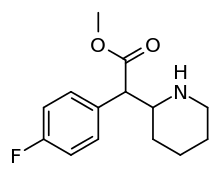4-Fluoromethylphenidate
4-Fluoromethylphenidate (also known as 4-FMPH and 4F-MPH) is a stimulant drug that acts as a higher potency dopamine reuptake inhibitor than the closely related methylphenidate.[2][3][4]
 | |
| Legal status | |
|---|---|
| Legal status |
|
| Identifiers | |
IUPAC name
| |
| CAS Number | |
| PubChem CID | |
| ChemSpider | |
| Chemical and physical data | |
| Formula | C14H18FNO2 |
| Molar mass | 251.3 g/mol g·mol−1 |
| 3D model (JSmol) | |
| Melting point | 222.0[1] °C (431.6 °F) |
SMILES
| |
InChI
| |
4-Fluoromethylphenidate was studied further along with other analogues of (±)-threo-methylphenidate (TMP) to assess their potential as anti-cocaine medications. 4F-MPH was reported as having an ED50 mg/kg of 0.26 (0.18–0.36), regarding its efficacy as a substitute for cocaine, and a relative potency of 3.33 compared to methylphenidate for the same purpose.[5]
Another study found that in the threo-isomers of methylphenidate, the meta- and para-substituted compounds with electron-withdrawing substituents tended to have increased binding potency. Compounds containing fluorine, chlorine, bromine and methyl groups were reported to be more potent than methylphenidate as well as the closely related compound 4F-EPH. 4F-MPH was reported as having the following values: [3H]WIN 35428 binding of 35.0 ± 3.0 (2) and [3H]dopamine 142 ± 2.0 (2).[6]
Legal status
4-Fluoromethylphenidate is a Schedule I controlled substance in the US state Alabama.[7] As of 5 May 2017, 4-fluoromethylphenidate is a controlled substance in Canada.[8]
See also
References
- "The Drug Enforcement Administration's Special Testing and Research Laboratory Monograph" (PDF). February 2017.
- Huw M.L. Davies; Darrin W. Hopper; Tore Hansen; Quixu Liu; Steven R. Childers (April 2004). "Synthesis of methylphenidate analogues and their binding affinities at dopamine and serotonin transport sites". Bioorganic & Medicinal Chemistry Letters. 14 (7): 1799–1802. doi:10.1016/j.bmcl.2003.12.097. PMID 15026075.
- Milind Misra; Qing Shi; Xiaocong Ye; Ewa Gruszecka-Kowalik; Wei Bu; Zhanzhu Liu; Margaret M. Schweri; Howard M. Deutsch; Carol A. Venanzi (October 2010). "Quantitative structure–activity relationship studies of threo-methylphenidate analogs". Bioorganic & Medicinal Chemistry. 18 (20): 7221–7238. doi:10.1016/j.bmc.2010.08.034. PMID 20846865.
- Satendra Singh (February 2000). "Chemistry, Design, and Structure−Activity Relationship of Cocaine Antagonists". Chemical Reviews. 100 (3): 925–1024. doi:10.1021/cr9700538. PMID 11749256.
- M. M. Schweri; H. M. Deutsch; A.T. Massey; S. G. Holtzman (May 2002). "Biochemical and Behavioral Characterization of Novel Methylphenidate Analogs". The Journal of Pharmacology and Experimental Therapeutics. 301 (2): 527–535. doi:10.1124/jpet.301.2.527. PMID 11961053.
- Howard M. Deutsch; Qing Shi; Ewa Gruszecka-Kowalik; Margaret M. Schweri (March 1996). "Synthesis and Pharmacology of Potential Cocaine Antagonists. 2. Structure−Activity Relationship Studies of Aromatic Ring-Substituted Methylphenidate Analogs". Journal of Medicinal Chemistry. 39 (6): 1201–1209. doi:10.1021/jm950697c. PMID 8632426.
- "Alabama Senate Bill 333 - Controlled substances, Schedule I, additional synthetic controlled substances and analogue substances included in, trafficking in controlled substance analogues, requisite weight increased, Secs. 13A-12-231, 20-2-23 am'd". March 2014. Retrieved 28 September 2015.
- Regulations Amending the Food and Drug Regulations (Part G — Methylphenidate)-4-Fluoromethylphenidate (methyl 2-(4-fluorophenyl)-2-(piperidin-2-yl)acetate). http://www.gazette.gc.ca/rp-pr/p2/2017/2017-04-05/html/sor-dors43-eng.php